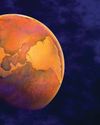
The concept of lunar and planetary orbits can be difficult for beginners to grasp. This simple flat model will help you to introduce these ideas by showing that the Moon is in orbit around Earth, but the Earth-Moon system is also orbiting the Sun. The model is easy to make using just one sheet of A4 card, some paper fasteners and a dash of artistic flare.
Although Earth and the Moon in our model are the correct sizes relative to each other, it goes without saying that the size of the Sun and the distances between the bodies are not to scale. If they were, our Sun would have a diameter of 10.9 metres, the distance between Earth and the Moon would be 2.76 metres and the distance between the Sun and Earth would be 1.2km. If the Sun and Earth were the correct sizes relative to the distance in our model, the Sun would have a diameter of approximately 2mm and the Earth a diameter of approximately 0.018mm. The surprising size of these numbers is a great teaching opportunity, conveying the fact that space is big! Models and diagrams commonly used to show our Solar System are never to scale because the relative sizes and distances are far too large.
There are several more learning outcomes from creating this project. When drawing Earth, there is much to learn about the geography of our home planet - not just the shapes of the continents, but also why some areas are very green and lush while others are brown and arid. There are many photographs of Earth as seen from space online, so choose one that shows the continent where you live.
Sketch the surfaces
This story is from the July 2023 edition of BBC Sky at Night Magazine.
Start your 7-day Magzter GOLD free trial to access thousands of curated premium stories, and 9,000+ magazines and newspapers.
Already a subscriber ? Sign In
This story is from the July 2023 edition of BBC Sky at Night Magazine.
Start your 7-day Magzter GOLD free trial to access thousands of curated premium stories, and 9,000+ magazines and newspapers.
Already a subscriber? Sign In

Putting cosmic rays to work
These penetrating interstellar particles have applications from astronomy to archaeology

Set up your first imaging sequence
How to automate and coordinate your gear over multiple nights of imaging

The Universe without gravity
Life with no gravity might sound a fun idea, but as Govert Schilling explains, shutting off this pivotalforce would spell disaster for Earth and beyond

How to blend images taken with different camera setups
Combine data captured at varied focal lengths to create rich, deep images

INSIDE THE SKY AT NIGHT
Back in September 2021, The Sky at Night show spoke to Carly Howett about NASA's then upcoming Lucy mission. As the spacecraft now approaches its main targets - the Trojan asteroids - we check in with her to see how the mission is going

The science of SCI-FI
We love a good sci-fi film, but do they get the science right? Amy Arthur picks six of the big mistakes made in space films

Seeing in a new light
It's National Astronomy Week this month, so take a tip from Mark Westmoquette and let mindful stargazing change your perspective on your life and problems

What to do if you find a meteorite
Ever come across an unusual rock and wondered if it's a meteorite? Mark McIntyre explains how to tell if that stone really is a fragment from outer space

GEAR
Charlotte Daniels rounds up the latest astronomical accessories

Q&A WITH A STELLAR ECLIPSE SPECIALIST
Many stars are gravitationally locked inside multi-star systems, but a rare new triple-star system has set a new record for how cosy these clusters can get